Centauri Dreams
Imagining and Planning Interstellar Exploration
Mapping Asteroid Bennu
The holiday season seems an appropriate time to thank not only my Centauri Dreams readers for their continued high level of discussion in these pages, but also the army of citizen scientists who are out there working on everything from exoplanet detection to asteroid mapping. We saw recently how valuable the work of amateurs like Thiam-Guan Tan can be in confirming a possible exoplanet, while projects like the Habitable Exoplanet Hunting Project continue coming online to push the boundaries of what amateur equipment can do.
Now comes word of the signal contribution made to OSIRIS-REx and its mission to asteroid Bennu. You’ll recall that when the spacecraft arrived at the asteroid, the surface was found to be far more littered with rocks and boulders than anyone had foreseen. Finding a spot for landing and retrieving samples would be no easy task, but it was made substantially more manageable by a team of 3,500 people using their PCs to join in analysis and characterization of the asteroid surface.
These volunteers measured boulders and marked craters, eventually tallying over 14 million annotations of features on Bennu’s emerging global map. Behind all this work was CosmoQuest, a project based at the Planetary Science Institute in Tucson, Arizona.
“It is amazing that more than 3,500 citizen scientists participated in CosmoQuest’s project to map Bennu and help mission scientists find the best place for OSIRIS-REx to collect a sample,” said Pamela L. Gay, Senior Scientist and Senior Education and Communication Specialist at PSI. “This kind of a volunteer effort makes it easier to find safe places to sample and scientifically interesting places to explore.”
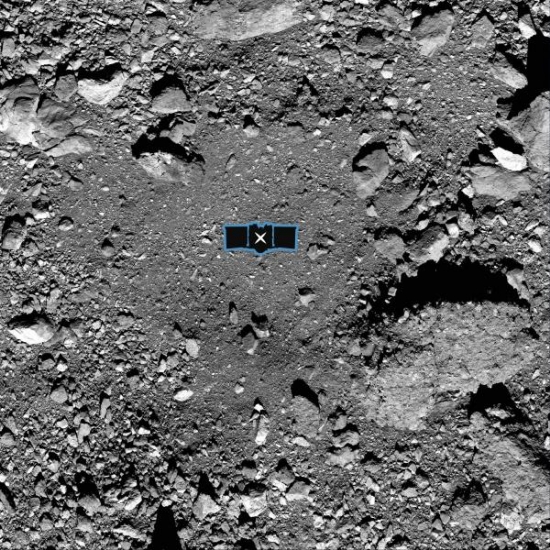
Image: This image shows sample site Nightingale, OSIRIS-REx’s primary sample collection site on asteroid Bennu. The image is overlaid with a graphic of the OSIRIS-REx spacecraft to illustrate the scale of the site. Credit: NASA/Goddard/University of Arizona.
During the four month period needed to complete the mapping, some volunteers marked more than 500 images (the average was closer to 10), with each image taking up to 45 minutes to complete. It seems worthwhile to list the usernames of those with the greatest number of contributions: MikeCassidy, Nilium, bc2callhome, zathras, joed, dpi209, and pattyg. PSI’s CosmoQuest team will continue working with the Bennu science team to generate science drawn from the mapping data now that the initial site selection has been performed.
If you missed out on the Bennu mapping but would like to get involved, CosmoQuest intends to be launching new citizen science projects some time in 2020, so keep an eye on the site. A good New Year’s resolution might be to get involved in one or more of the many sites catering not just to amateur astronomers but interested laypeople willing to devote time to image analysis. Have a look, for example, at Zooniverse’s list of projects on physics to get an idea of the range. It’s clear that space missions draw real value out of the kind of citizen participation that, not so many years ago, was limited to watching images on a television. Actually joining in efforts that can assist a mission or discover new worlds through its data is no longer a novelty.
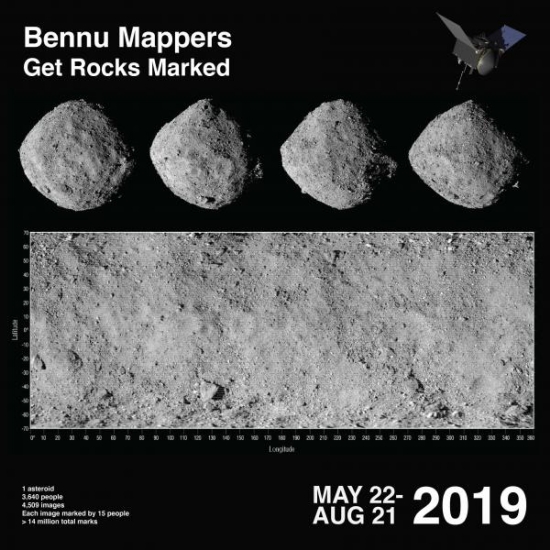
Image: All 3,640 names of the Bennu Mappers are superimposed on this Global Mosaic of the Bennu Asteroid that was acquired by the OSIRIS-REx Mission (the image has to be blown up several times to actually see the names). Credit: Created using sources images from NASA/Goddard/University of Arizona.
Let me wish all of you a wonderful holiday and an energized return to work when the season ends. Working on behalf of ideas one believes in is a high vocation. Let’s continue to focus in 2020 on pushing the seemingly intractable problem of interstellar flight forward with new ideas and clarifications of the old.

CHEOPS Enters the Game
The Egyptian monarch Khufu was the second pharaoh of the Fourth Dynasty, which dates him back to the earlier years of the Old Kingdom period around the 26th century BC. I mention this figure, about which all too little is known, because his name is a link between the great monuments of an early culture (Khufu seems to have commissioned the Great Pyramid of Giza) and present-day engineering. Imagine how wondrous the Great Pyramid would have been to the average passerby of the time, and then realize that Khufu’s Hellenized name was Cheops, a monicker reflected in the acronym of our recently launched CHEOPS exoplanet observatory.
I always enjoy untangling acronyms, some of which are more labored than others. Did you know, for example, that the name of the Japanese IKAROS solar sail is actually an acronym standing for Interplanetary Kite-craft Accelerated by Radiation Of the Sun? Then there’s OSIRIS-REx (also satisfyingly Egyptian), which weighs in as Origins, Spectral Interpretation, Resource Identification, and Security-Regolith Explorer (!) We can include the doughty EPOXI: Extrasolar Planet Observation and Deep Impact Extended Investigation. Compared with all this, the ESA’s CHEOPS is pretty straightforward: CHaracterising ExOPlanet Satellite.
Launched from Kourou (French Guiana) aboard a Soyuz-Fregat booster at 08:54:20 UTC on December 18, the CHEOPS telemetry was picked up by the Troll Satellite Station in Queen Maud Land, Antarctica, verifying its survival of launch for controllers at INTA (another acronym: Instituto Nacional de Técnica Aeroespacial, which is Spain’s space agency) in Torrejón de Ardoz, near Madrid, and now we have a new exoplanet asset ready to undergo the testing that will precede full operations. The international nature of exoplanet research is again highlighted as we contrast what CHEOPS will do with the ongoing activities of TESS, NASA’s Transiting Exoplanet Survey Satellite. For CHEOPS is not seeking new planets but following up on earlier discoveries, measuring planet sizes against mass information to derive planetary density.
So we combine mass information from radial velocity observations with transit data to work out density, a well researched combination of our two most productive discovery methods. CHEOPS ups the game with instrumentation mentioned below. It’s a collaborative project, being developed as a Small, or S-class, mission in ESA’s science programme through partnership with Switzerland, and including significant contributions from Austria, Belgium, France, Germany, Hungary, Italy, Portugal, Spain, Sweden, and the United Kingdom. A guest observer program offers 20 percent of the observing time to the astronomical community, with the other 80 percent being reserved for observations determined by the CHEOPS science team. It’s remarkable that the mission took only five years to go from project start to launch.
Günther Hasinger serves as the European Space Agency’s Director of Science:
“CHEOPS will take exoplanet science to a whole new level. After the discovery of thousands of planets, the quest can now turn to characterisation, investigating the physical and chemical properties of many exoplanets and really getting to know what they are made of and how they formed. CHEOPS will also pave the way for our future exoplanet missions, from the international James Webb Telescope to ESA’s very own PLATO and ARIEL satellites, keeping European science at the forefront of exoplanet research.”

Image: ESA’s Characterising Exoplanet Satellite, CHEOPS, lifts off from Europe’s Spaceport in Kourou, French Guiana. The Soyuz-Fregat launcher will also deliver the Italian space agency’s Cosmo-SkyMed Second Generation satellite, and three CubeSats – including ESA’s OPS-SAT – into space today. CHEOPS is ESA’s first mission dedicated to the study of extrasolar planets, or exoplanets. It will observe bright stars that are already known to host planets, measuring minuscule brightness changes due to the planet’s transit across the star’s disc. Credit: ESA – S. Corvaja.
Enough acronyms — we can unwrap PLATO and ARIEL as they once again appear in these pages down the road. What CHEOPS is all about, using transiting exoplanets as its fodder, is probing into the internal structure and composition of these worlds. Gaseous or rocky? Can we make inferences about possible atmospheres or oceans? Several hundred planets are under close investigation, all of them bright stars hosting known exoplanets in the size range between Earth and Neptune. ESA is saying that atmospheric observations including cloud cover may be possible for some, using phase curve methods that analyze reflected light as the planet orbits the host star.
Even moons or rings around some planets may be possible catches. As for new exoplanets, tight studies of the transits of known worlds may reveal by transit timing variations the existence of other worlds in the same system. CHEOPS may also snag a transit of planets previously known only through radial velocity study. We’ll be keeping an eye on CHEOPS and its high precision photometer, a 300 mm effective aperture telescope with CCD detector covering wavelengths between 330 and 1100 nm. Congratulations to the CHEOPS team on a successful launch and best wishes as operations commence in the observatory’s 700 km orbit.

Will Humans Ever Walk on Exoplanets?
Searching for biosignatures in exoplanet atmospheres is something we can look forward to in as little as a decade, judging from the progress now being made in planning future ground- and space-based telescopes. A key challenge is to catalog habitable zone planets upon which to practice our methods, and our tools for doing this are steadily evolving. Take ESPRESSO (Echelle Spectrograph for Rocky OxoPlanet and Stable Spectroscopic Observations), which can reduce a star’s movement to or away from us down to a minute 10 centimeters per second.
You can imagine what this means for radial velocity studies, which now routinely parse the to-and-fro of stellar motions as a way of detecting exoplanets. The smaller the gravitational effect we can detect, the sharper our observations, bringing much smaller planets in range. We move from hot Jupiters and Neptunes into the realm of Earth-mass worlds around stars like the Sun. Commissioned in 2017, ESPRESSO is installed at the European Southern Observatory’s Very Large Telescope in Chile, and exoplanet hunter Nuno Santos intends to put it to good use.
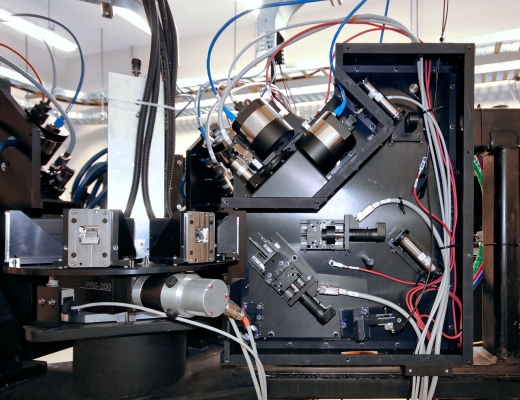
Image: The Echelle SPectrograph for Rocky Exoplanet and Stable Spectroscopic Observations (ESPRESSO) successfully made its first observations in November 2017. Installed on ESO’s Very Large Telescope (VLT) in Chile, ESPRESSO will search for exoplanets with unprecedented precision by looking at the minuscule changes in the properties of light coming from their host stars. This view shows the inside of one of the ESPRESSO front-ends where all the active components of the spectrograph are located. Credit: Giorgio Calderone, INAF Trieste.
I’m looking at a recent Bruce Dorminey article about Santos in Forbes, but before going deeper into ESPRESSO, I want to note the headline of the article: “‘Nonsense’ To Think Humans Will Ever Move to Nearby ExoEarth, Says Leading Planet Hunter.” This is what Santos (University of Porto, Portugal) believes, and it’s a sentiment that’s getting a fair bit of play around the Net. My first impulse was to agree with Santos, but then I realized how much is packed into that verb ‘move.’

If the idea is that we will never move humanity en masse to another star system (presumably because of some catastrophe on Earth), then I think Santos is exactly right. Try to imagine gigantic fleets of generation ships setting out to escape a dying Earth and the whole picture starts to pixelate. This reminds me a bit of a J.T. McIntosh novel called One in Three Hundred, which grew out of three novellas published in Fantasy and Science Fiction in 1953 and 1954. Their titles: “One in 300” (February 1953), “One in a Thousand” (January 1954), and “One Too Many” (September 54). You get the idea.
But I’d hate to think that an uncritical reading of Santos’ comment might fix in the public imagination the idea that research into interstellar travel is pointless. After all, when people from Europe began to explore the other side of the planet and settle in places like Australia and New Zealand, only a small percentage of the European population ever made the daunting journey. A few pioneers risk everything, then commerce gradually emerges amidst scientific follow-ups, and over time a new population, born and raised in the new territories appears. If we somehow solved the problem of getting humans to other stars, that pattern could conceivably reappear.
There are no guarantees that human interstellar travel will happen in the first place, but if it does, it will be because robotic probes have led the way — our AI Captain Cooks, if you will — while early attempts to colonize, if we were actually able to find a place where these could occur, would doubtless be the work of small groups with a variety of agendas. If the Earth they leave behind really did succumb to disaster, most of its population would die with it, another reason to keep this world healthy, study its systems and try to undo self-inflicted damage.
Recommended reading on this latter point is David Grinspoon’s Earth in Human Hands (Grand Central Publishing, 2016), which accepts a human future in space within the context of a healthy Earth and the moral choices that accompany action in the Anthropocene era, as Grinspoon would have it. But assuming human survival on a healthy Earth, my guess is that we’re going to find sending robotic probes with a reasonable travel time much harder than we’ve imagined. I do think that sometime within the next 100 years or so, we’ll accomplish it. Whether we get to humans aboard interstellar craft is dependent on so many contingencies that I can’t assign a probability to it. I hope we figure it out.
But back to ESPRESSO. Santos is a former grad student who worked under Michel Mayor (not bad to come up under the tutelage of a Nobel Prize winner!) He sees us building a catalog of potentially habitable planets from which we can choose the best candidates for biosignature analysis, presumably through space-based instruments and the coming generation of extremely large telescopes (ELTs). ESPRESSO, which can combine the light of all four of the VLT’s telescopes to achieve the light-collecting power of a 16-meter telescope, is a game-changer.
Low mass planets require stable instruments, but even the famed HARPS spectrograph (High Accuracy Radial velocity Planet Searcher) at the ESO La Silla 3.6m telescope can only get us down to a bit lower than 1 meter per second. ESPRESSO’s 10 centimeters per second takes us into the realm of detecting a habitable zone planet that allows radial velocity methods to keep contributing, along with transits and gravitational microlensing, to the biosignature target list.
Will humans someday walk on such worlds? The first goal will be to survive all the traps our increasingly complex technologies set for us. This is the L term in Frank Drake’s famous equation, measuring how long a technological society lasts. If we manage to get through this filter, robotic probes will take our sensors increasingly far from Earth. It will only be through the lessons learned from such craft, and the decisions we make about the value of human vs. artificial presence on worlds like these, that we will learn how to answer this question.

SWIMMERs: A Thought Experiment on the Potential and Limitations of Propellantless Interstellar Travel
Can we tap ionized particles in the interstellar medium as a way of exchanging momentum for propulsion? It’s a concept with a lot of pluses if it can be made to work, chief among them the fact that such a device would be propellantless. Looking at the topic today is Drew Brisbin, a postdoctoral researcher in astronomy who received his PhD from Cornell University in 2014. Dr. Brisbin has since gone on to work towards better understanding his field of specialization: the study of galaxy evolution in the early universe. He currently works at Universidad Diego Portales, in Santiago Chile, where he collaborates closely with other researchers using some of the most sensitive telescopes in the world, located in the mountainous Chilean desert. In addition to his formal work and outdoors-oriented hobbies, he also enjoys dreaming about the future of humanity. One particular dream recently seemed to warrant some further investigation, leading him to the ideas he explains today.
By Drew Brisbin
Foreword
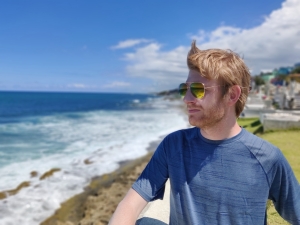
This article represents a distillation of a work published in April 2019 in the Journal of the British Interplanetary Society (reference [0]). Some technical details have been omitted for brevity, but interested readers are encouraged to read the original publication which is freely available at https://arxiv.org/abs/1808.02019. Additional commentary has been included to address what the author sees as a critical flaw in Dr. Robert Zubrin’s “Dipole Drive” concept.
Abstract
In particular light of the recent public excitement and ensuing disappointment regarding the exotic “EM drive” it is worthwhile to point out that space travel without on-board propellant is eminently possible based on well established physical principles. Here a new mode of transport is proposed which relies on electric-field moderated momentum exchange with the ionized particles in the interstellar medium. The application of this mechanism faces significant challenges requiring industrial-scale exploitation of space but the technological roadblocks are different than those presented by light sails or particle beam powered craft. This mode of space travel is well suited to energy efficient travel at velocities below about five percent the speed of light (0.05 x c) and compares exceptionally well to light sails on an energy expenditure basis. It therefore represents an extremely attractive mode of transport for slow (of order multi-century long) voyages carrying massive payloads to nearby stellar neighbors. This will be a useful niche for missions that would otherwise be too energy intensive to carry out, including initial forays into nearby stellar systems with observatory probes, or long term transport of bulk materials as a precursor mission to set up colony infrastructure.
Introduction
The tyranny of the rocket equation has long been recognized as an impediment to becoming a truly spacefaring species. Due to the exorbitant reaction mass required for traditional rockets in interstellar travel, there has been considerable attention to methods of space travel that circumvent the rocket equation. Laser-driven light sails are a prominent and long-standing idea (see for example [1] and references therein). While light sails are well established and also the engines of the widely publicized Breakthrough Starshot program [2] and Project Dragonfly [3], their thrust is fundamentally limited to 6.67 N/GW. For comparison, the Three Gorges Dam, the largest capacity power plant currently in operation, has a capacity of about 22.5 GW. If this power was transmitted with perfect efficiency to a light sail it would provide thrust equivalent to the force required to lift a 15 kg mass on Earth. Scaling light sails up to larger-than-gram-scale spacecraft therefore necessarily depends on humanity’s ability to harness incredible power. Furthermore, since light is only able to push, it is very difficult for light sail spacecraft to slow down at their destination, limiting missions to fly-bys unless complicated reflecting infrastructure can be sent ahead of the craft. Alternatively, direct sunlight could be used as a source of photon pressure. Unfortunately, the material properties suggested to be necessary for a practical interstellar solar sail require materials with extremely low areal densities with σ≲10-3 g/m2 [4]. Current state-of-the-art reflective films developed for light sails reach areal densities of order 10 g/m2, or four orders of magnitude too dense even without including any support structure or payload, so it is uncertain when if ever suitable materials will be developed for an interstellar solar sail [5].
Another idea using external reaction mass is the particle-beam powered spacecraft. This hinges on a sail formed by an extended electric or magnetic field which is able to deflect a remotely-beamed stream of charged particles. Since charged particles carry much more momentum per unit energy than photons this could have much lower power requirements than light sails. This concept has its origins in the Magsail, a large loop of current carrying wire which deflects passing charged particles in the interstellar medium (ISM), eliciting a drag force which could be used as a brake to slow spacecraft down to rest with respect to the ISM after a high speed journey [6]. To provide acceleration, one could simply supplant the ISM with a beamed source of high velocity charged particles [7]. Providing a long distance beam of charged particles is, however, quite difficult because of beam divergence due to particle thermal motion, interaction with interplanetary or interstellar magnetic fields, and electrostatic beam expansion in the case of non-neutral particle beams. Andrews (2003) suggests that it would be necessary to construct a highway of beam generators at least every AU or so along the route on which the craft accelerates [8]. The related concept of the electric sail instead uses an electric field generated by a positively charged grid of wires or wire spokes extending from a central hub to push against the outward streaming solar wind [9]. This concept has the near term potential to allow travel within our own stellar neighborhood with very low energy costs. The electric sail, like the Magsail however, ultimately relies on a drag force, decelerating the spacecraft to rest with respect to the surrounding medium (the outward moving solar wind in this case). It is therefore unable to accelerate beyond the heliosphere, nor can it accelerate directly inwards towards the sun while in the heliosphere.
It would be possible to overcome these obstacles by actively pushing against the charged particles of the ISM, rather than passively coming to rest with respect to the medium. These spacecraft with interstellar medium momentum exchange reactions (SWIMMERs) can accelerate with respect to the ISM, are significantly more energy efficient than light sails, would be able to decelerate at their destination, do not require pre-established infrastructure along the route and are based on elementary physical principles. Recently Dr. Robert Zubrin discussed his independent work on a “dipole drive” concept which is similar to the SWIMMER concept described here [10,11]. Although the two ideas are related and even share a similar geometry, they were arrived at independently. Furthermore the dipole drive as described, suffers from a flaw which prevents its successful acceleration in the stationary ISM. The work presented here concerns the conceptual mechanism which allows SWIMMERs to accelerate through a stationary ISM.
Both the Magsail and electric sail concepts rely on the fact that there is significant mass in the ISM (or the heliosphere) which can interact with relatively low mass structures consisting of charged or current carrying wires. How, then, could a spacecraft interact to accelerate rather than decelerate with respect to the surrounding medium?
The need for a time varying electrical voltage
Quite generally this will require a time varying electric field which can do work on the surrounding particles of the ISM. As a thought experiment, imagine a spacecraft consisting of a pair of conducting plates arranged in a parallel-plate capacitor style configuration with a switchable power source connecting them and able to charge and discharge them at will. The conducting plates, rather than being solid, are composed of a wire mesh with the vast majority of the area taken up by open space rather than metal, such that particles are easily able to pass through the plate mesh without collision. The spacecraft is moving face on through a stationary medium of charged particles (like the interstellar medium), as shown schematically in Fig. 1. For the moment take the charged particles to be macroscopic and extremely dispersed so we can easily see individual particles and identify when they are in the vicinity of the spacecraft — charged pebbles rather than atoms or elementary particles. As the spacecraft moves through the field of charged particles we can strategically switch the power source on and off to create an electric field and push on charged particles as they pass between the conducting plates, accelerating the particles backward and creating thrust to push the spacecraft forward (Fig. 1). This scenario is perfectly in line with conservation laws. momentum is conserved since the particle gains momentum in the backward direction and the spacecraft gains momentum in the forward direction. Energy is conserved as the increase in kinetic energy (of the particle and the spacecraft) is drawn directly from the power source depleting whatever energy source is being used (depleting a battery’s chemical energy, or converting beamed laser light for instance).
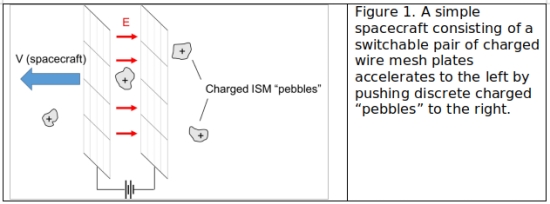
In practice of course, the ISM is not made of macroscopic, easily separable pebbles, but microscopic ions and electrons with tens of thousands per cubic meter or more, so we cannot consider manually switching the charged plates based on the positions of individual particles. The possibility of simply leaving the plates continuously charged, front facing plate positive, back plate negative, may initially seem workable, and this appears to be the scenario imagined in the “Dipole Drive” [10]. Introductory electricity courses train us to think about parallel plate capacitors as having a strong field in one direction between a pair of charged plates, and no field outside the plates, so it is easy to initially imagine that a positively charged ion would approach the front plate while feeling absolutely no force, feel a strong force backwards while between the plates, and then feel absolutely no force again as it recedes beyond the back plate. In fact, however, a set of finite parallel plates will indeed have electric fields outside of their gap which directly oppose the electric field inside the gap, and would perfectly negate the thrust generated by particles transitioning the gap.
This is made more clear by considering the electrical voltage rather than electric fields. Fig. 2 (top) shows schematically the voltage through the center of an idealized infinite parallel plate capacitor charged to a potential difference of 2V. Positive charges will want to “slide down” the potential ramp located between the plates, accelerating rightward. For a finite sized set of parallel plates the voltage extends a bit to the left and right of the gap, continuously decaying from the voltage at the plates to a voltage of zero at great distances as shown in Fig. 2 (middle). Note that these voltage ramps tilt in the other way than the region between the plates and will tend to accelerate positive charges in the opposite direction. For a particle entering in from the left and making it all the way through to exit out the right side, would it end up with more or less rightward velocity? Remember that voltage (often referred to as electric potential) is simply potential energy divided by charge (in SI units 1 volt = 1 joule/coulomb). Starting out very far on the left in Fig. 2, the rightward traveling particle with charge q will have some kinetic energy, KE, and zero potential energy.
As it approaches the front plate, it will begin slowing down as it rises up the potential ramp and converting kinetic energy to potential energy, eventually reaching a peak potential energy of +qV (with a kinetic energy of KE-qV). As it traverses the gap it is accelerated rightward as it slides down the potential, eventually reaching a potential energy of -qV and a kinetic energy of KE+qV. It then exits the parallel plate gap and is again forced up a potential ramp, converting kinetic energy back into potential energy, until it finally reaches distances far away from the plates where the voltage is 0 at which point it has potential energy 0 and kinetic energy KE — exactly the same as it started.
This is not a minor fluke of this particular geometry either. Any arrangement of charged plates – so long as the voltage is finite and the plate volume is finite – will leave the potential 0 at infinity. In [11] Zubrin has suggested that Debye shielding (the phenomenon of oppositely charged free particles in a plasma tending to cluster around charged objects and screen out the electric field) would somehow ameliorate this issue, but that is not the case. The effect of Debye shielding will be for the front facing positive plate to accumulate a cloud of electrons and the back plate to accumulate a cloud of positive ions, making the voltage ramps just outside the plate pair more steeply return to zero, as shown in Fig. 2 (bottom). Nonetheless, the potential remains 0 at large distances and in the end passing particles enter and leave the system with the exact same kinetic energy. This does not preclude the particles from changing direction, either being reflected back in the direction they came, or deflected to the side if they interact with the parallel plates at an angle, so such a configuration could certainly be used to either steer or decelerate with respect to the charged particle medium, but such a system with constant voltages cannot do work on charged particles which begin and end far away, and cannot accelerate with respect to them (it could still be useful to accelerate up to the velocity of the solar wind inside our heliosphere, much like the electric sail).
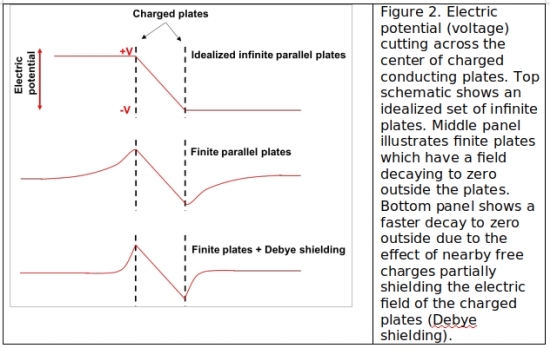
If the goal is to accelerate in the dead of the ISM, it is essential that a time-varying electrical potential be used to do work on the passing particles. There are multiple ways to do this, but one simple implementation, illustrated in Fig. 3, could feature a pusher plate made of a large grid of wires moving face-on through the ISM (much like the proposed geometry of a standard electric sail). Unlike a standard electric sail, however, the grid of wires would actually be two identical layers of wire sandwiching a strong insulator between them to keep the two layers physically apart and electrically isolated. These wire grids or tethers could be made from very fine superconducting wire and the entire ensemble could be spun to create tension and keep the wire grids extended without heavy support structure. The two faces of the pusher plate would be charged and discharged cyclically. In the “primer” portion of the operation cycle, the front layer in the pusher plate is raised to a positive potential and the back layer to an equal negative potential. Due to edge effects of the finite plates and the self-shielding behavior of plasmas, this results in a decaying electric potential of opposite sign on either side of the plates. Ions streaming towards the front positively charged layer slow down, building up an overdense clump in front of the pusher plate while an underdensity forms at the immediate location of the pusher plate. Then in the “pull” stage of the cycle the potential difference across the layers is reversed and significantly increased. The ion clump that was formed in front of the plate will be attracted to the negative front layer, pulling the spacecraft forward. As the clump approaches the pusher plate, the potential difference is turned off and the clump is allowed to coast through the plate to the other side. In the final “push” stage the same potential difference is applied and the clump is further pushed backwards by the positive back layer of the pusher plate. The clump drifts away beyond the influence of the pusher plate and the cycle repeats. Fig. 4 shows the electric potential and ion density at various cycle stages for a simple model.
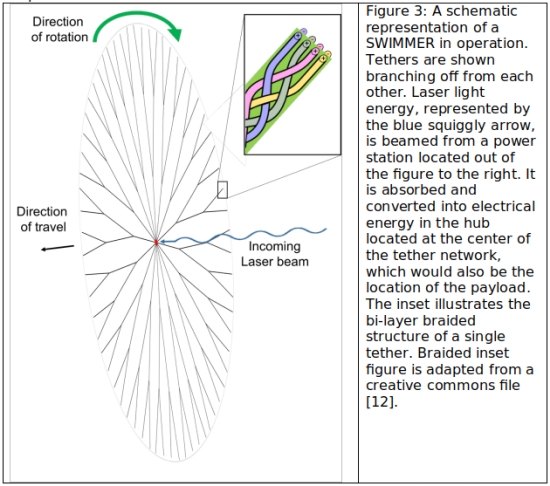
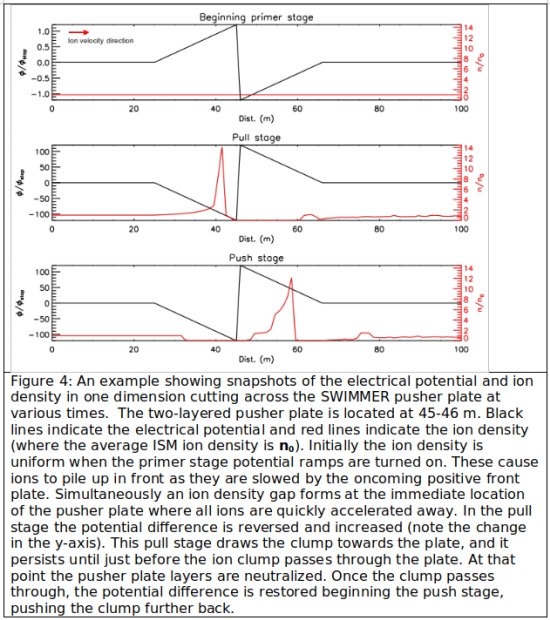
By intentionally setting up clumps in the oncoming ISM we can interact with it much more like in our initial thought experiment with charged pebbles. The spacecraft gains momentum by giving backward momentum to the ISM (pushing ion clumps to the right in Fig. 4). The source of the potential difference does work in the primer stage when it sets up the positive potential, raising the electrical potential energy of the ions in front and again in the push stage when it raises the ion clump to a higher potential. Electrons encountering the potential ramps will largely be reflected but this causes only a negligible momentum drag since they are far less massive than the protons and other positively charged ions. In a real three dimensional case, there will also be loss of efficiency due to particles which do not interact perfectly in one dimension, but instead are pushed off to the side as they pass by the charged wires. Furthermore, this qualitative conceptual analysis does not account for the self influencing behavior of plasmas. This will undoubtedly strongly affect the ion (and electron) distributions and the extended electric potential. Detailed particle-in-cell simulations will be necessary to investigate the optimal tuning of cycle timings, electrical potentials, and even geometry of the charged plates as it may be advantageous in some cases to accelerate ion clumps across a series of potential differences to gain more thrust per ion, at the expense of a more complex and massive pusher plate. These simulations are beyond the scope of this work but will be a critical step in transitioning the concept from a thought experiment to a practical real world device.
Mathematical expression of an idealized case
While the effectiveness and geometry of a SWIMMER will ultimately need to be tested thoroughly by simulation, it is straightforward to represent the force on an idealized system which is able to efficiently convert electrical power, P, into backwards acceleration of nearby particles. The resulting force, FSWIMMER, is
![]()
where mp is the particle mass (of order the proton mass for the ISM), n is the density of particles, v is the velocity of the spacecraft (with respect to the stationary-particle frame), and A is the cross sectional area over which the system can interact with particles (or equivalently v x A is the volume rate of particles swept out by the spacecraft through time). The positive sign is used when accelerating with respect to the the stationary-particle frame, and the negative sign is used when decelerating. The derivation of this relationship is shown in [0].
The power referred to throughout this work is the delivered electrical power. Thus far the source of power for a SWIMMER has been ignored. There is no reason a SWIMMER could not use an onboard power source, making it totally independent of external infrastructure. This, of course, would require an exceptionally energy dense fuel source as well as a very efficient generator to achieve useful velocities for interstellar travel. Beaming power remotely to the SWIMMER is possibly a more viable strategy for interstellar travel, which invites a direct comparison to light sails. In this case an additional P/c term is included in eq. 2, corresponding to the photon pressure of the beamed energy being absorbed by the spacecraft. The total force is then:
![]()
Where P/c is either added or subtracted depending on if the beamed energy source is coming from the origin or the destination respectively. It will also be useful to consider the ratio, R, of the force on a SWIMMER to the force on an ideal light sail with equal delivered power (F=2 P/c). This ratio can be written as:

where we have used the the positive signs in the SWIMMER and photon forces indicating the spacecraft is accelerating and beamed energy is coming from the origin (as would be the case for an initial out-bound journey to another star system). In Fig. 5 R is shown as a function of velocity for a few values of A/P. There is some uncertainty surrounding the structure and properties of the local ISM, but there is general consensus that a journey to Cen A will involve passage through some combination of the Local Interstellar Cloud, the Circum-Heliospheric Interstellar Medium and the G Cloud. Therefore, a conservatively low ion density of n=0.07 cm-3, consistent with the estimated densities in these clouds, (see for example [13]) is used in Fig. 5. Fig. 5 shows the force initially rising with velocity due to the fact that at higher velocities the SWIMMER plates are sweeping out larger volumes of the ISM faster and able to interact with more particles per second. The force peaks at some velocity, and then decreases since it takes more and more energy to accelerate the passing ions to yet higher velocities to get the same momentum change. Due to this initial rise in force with velocity, it may be useful to give SWIMMERs an initial velocity boost through other means (such as conventional rockets, gravitational assists, or particle beam assists) to take advantage of the forces at higher velocities.
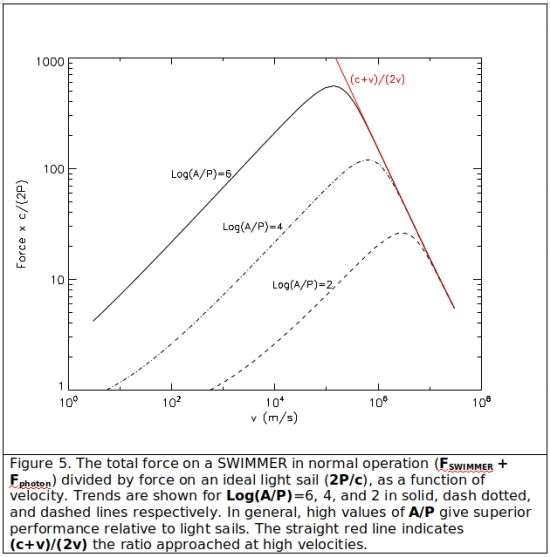
Larger A/P values give significantly better performance at lower velocities, but trend together as velocity increases, with the force approaching (P/v) x (c+v)/c (the ratio R approaches (c+v)/(2v), shown by the red line in Fig. 5). This high velocity limit implies an order of magnitude larger force for SWIMMERs relative to light sails up to v=c/19 or about 5% the speed of light.
Example mission
To illustrate the potential of SWIMMERs for interstellar travel, it is helpful to consider a possible future mission. Further details and technical considerations are available in the published manuscript, but here we simply assume the the engineering difficulties of beaming power to interstellar distances is solved, and the onboard energy converter has a specific power capacity of 4 kW/kg (every 4 kW of delivered power requires an increase of 1 kg in the mass of the power converter equipment). The ISM is assumed to be uniform with a density of 0.07 cm-3, a temperature of 7000 K and therefore an electron Debye length, λD=21.8 m.
A relatively lower mass SWIMMER mission might have the goal of transporting a modest space probe, mpay=1000 kg to α Cen A. Accelerating within our heliosphere and decelerating at the destination are possible, and in fact relatively energy efficient but discussion of these will be left for the main publication, [0], for brevity. A modest electrical power delivered to the SWIMMER of 10 MW is assumed. The pusher plate will be made up of several long tethers. In practice these tethers will consist of very fine braided filaments to prevent failure due to micrometeoroid and interstellar dust collision, as described for the electric sail [9]. From a material mass standpoint these are considered to be single wires with an effective diameter of 30 μm. This is equivalent in material to eight filaments with diameters of about 10 μm. Given the pulsed nature of the SWIMMER electric field, the wire tethers should be made out of superconducting materials. A single charged wire will interact with charged particles passing within about λD on either side of it. The total cross sectional interaction area is given by
![]()
where L is the summed length of all the tethers. This cross sectional interaction area is somewhat of an idealization as the Debye length does not represent a hard cut off where particles suddenly cease to be effected by an electric field, and in regions where tethers intersect, part of their cross sectional areas will overlap. Nonetheless it is a sufficient estimate for our rough calculations. The mass devoted to this pusher plate will be mpusher= ρ x L x π rwire2. Where rwire represents the effective radius of the wire tether (15 μm in our case), and ρ represents the density of the tether material, which we will take to be 2570 kg/m3, the density of the popular superconducting material, magnesium diboride.
The total mass of the SWIMMER ship is comprised of mpay=1000 kg, mpower=2500 kg (given by the 10 MW supplied electric power and a 4 kW/kg specific power), and mpusher. We will take 7400 kg as the mass of the pusher plate which provides for a total summed tether length of 4.1 x 109 m. While this is seemingly a very long tether, it does not in any way represent the spatial scale of the SWIMMER, as the pusher plate will be made up of several thousand tethers, possibly splitting off from each other at greater radial distances. The summed length is merely a useful value for determining the total cross sectional area in plasmas of different temperatures and densities. In this case, from eq. 4 our SWIMMER tether length corresponds to a cross sectional interaction area of 180,000 km2 (about the size of Uruguay or the state of Washington).
We will begin our voyage as the SWIMMER enters the ISM at 100 AU with a velocity of 4.0 x 105 m/s (0.133% the speed of light and consistent with typical velocities of the solar wind). Iteratively integrating using eq. 3, we find that after just less than 300 years the spacecraft will be on the doorstep of Alpha Centauri after having travelled one parsec and achieving a final velocity of 1.66% the speed of light. Including time to initially accelerate from rest within the heliosphere and decelerate at the destination marginally increases the trip time, but we could also shorten the trip slightly by systematically shedding mass and reducing the size of the pusher plate enroute. As Fig. 5 shows, at higher velocities larger plate areas provide diminishing returns, so as the spacecraft reaches higher velocities the larger area of the pusher plate becomes dead weight. A total journey of about 300 years starting from rest in the solar system to being gravitationally captured by Cen A is reasonable for the overall journey [0].
While 300 years is a significant amount of time for a scientific endeavor, there is good precedent for multi-century science projects for worthwhile investigations (c.f. [14-16]). Furthermore, the energy expense is a pittance compared to an equivalent mission using laser-pushed light sails. An equivalent, 7400 kg probe pushed by 10 MW of laser light incident on ideal light sails (and starting with a velocity 4 x 105 m/s) would take about 1600 years to travel 1 parsec and reach a final velocity of 0.28% the speed of light. To reduce the light sail travel time to 300 years would require an average power consumption of nearly 700 MW (70x higher).
Conclusion
SWIMMERs represent a new mode of interstellar transport. By disposing of onboard reaction mass they circumvent the rocket equation, and by exchanging momentum with ions in the ISM they improve by orders of magnitude over the energy efficiency of traditional light sails at relatively low velocities. The key to this momentum exchange is the time varying electric field which allows SWIMMERs to create inhomogeneities in the surrounding plasma and then push on these inhomogeneities to create thrust.
SWIMMERS perform exceptionally well at lower velocities, with their advantage over light sails diminishing quickly at v > 0.05 c. Furthermore, by relying on the ambient ISM as a momentum exchange medium, they are quite versatile, able to accelerate either away or towards a beamed energy source, opening up myriad opportunities to serve as one-way transport, roundtrips or even statites remaining in stationary positions with respect to the Sun and serving as useful waypoints with infrastructure for other potential space transportation networks.
The example discussed here only scratches the surface of the possible roles for SWIMMERs in our spacefaring future. Their characteristics make them ideal for any mission with large masses in which relatively low velocities are acceptable. They are unlikely to be the sole mode of space transport due to their diminishing advantages at high velocities and their structural complexity which requires onboard power conversion systems with significant mass. They can play the role of the proverbial Mack trucks of space, transporting goods slowly and reliably at a low energy cost, while more time sensitive cargo can make use of fast yet inefficient light sails – the Ferraris of space. SWIMMERs might, for instance, be well suited to aiding the construction of a fast interstellar highway by transporting massive particle beam stations along with their fuel supply out to stationary positions between us and our target destinations. These particle beam stations could be used to swiftly carry low mass Magsails along the path or augment the power of future SWIMMERs by replacing the stationary ISM with a corridor of fast moving beamed particles.
The mission analyzed here regards a one-way interstellar trip. While it does push the limits of current technology by assuming relatively high specific power electrical systems, very thin mass-produced super conducting wire, and low mass electrical insulators which can resist large potential differences (as well as very large laser array optics which are addressed in other works regarding light sails) there is no obvious material or theoretical limits which would prevent such missions from realization. Future work in this vein will need to examine several issues ignored here. Areas of further investigation, include the efficiency of the SWIMMER drive in three dimensions; the electrical potential and cycle timings during the pulsed SWIMMER operation and how they effect the required current density of the tethers; the expected impact of interstellar dust collisions and redundant tether configurations to avoid catastrophic damage from tether breakage; and realistic limits on power conversion system capabilities.
As our understanding of interstellar travel develops, we must face the realization that, not only is it difficult, but there is no one-size-fits-all solution. Where SWIMMERs excel in one metric, other methods may excel in another. Ultimately our best strategy is to develop all possible methods in the hope that their synergy will provide a means to accomplish our goals.
References
0. D. Brisbin, “Spacecraft with interstellar medium momentum exchange reactions: the potential and limitations of propellantless interstellar travel”, JBIS, 72, pp.116-124, 2019.
1. R.L. Forward, “Roundtrip Interstellar Travel Using Laser-Pushed Lightsails”, J. Spacecraft and Rockets, 21, pp.187-195, 1984.
2. P. Lubin, “A Roadmap to Interstellar Flight”, JBIS, 69, pp.40-72, 2016.
3. N. Perakis, L.E. Schrenk, J. Gutsmiedl, A. Kroop, M.J. Losekamm, “Project Dragonfly: A feasibility study of interstellar travel using laser-powered light sail propulsion”, Acta Astronautica, 129, pp.316-324, 2016.
4. R. Heller, and M. Hippke, “Deceleration of High-velocity Interstellar Photon Sails into Bound Orbits at Centauri”, Astrophysical Journal Letters, 835, pp.L32, 2017.
5. D. Spieth, and R.M. Zubrin, “Ultra-Thin Solar Sails for Interstellar Travel–Phase I Final Report”, NASA Institute for Advanced Concepts, Pioneer Astronautics Inc, 1999.
6. D.G. Andrews, and R.M. Zubrin, “Magnetic sails and interstellar travel”, JBIS, 43, pp.265-272, 1990.
7. G.A. Landis, “Interstellar flight by particle beam”, in AIP Conference Proceedings, vol. 552, pp.393-396, 2001.
8. D.G. Andrews, “Interstellar Transportation using Today’s Physics”, Conference proceedings, American Institute of Aeronautics and Astronautics, 4691, 2003.
9. P. Janhunen, “Electric sail for spacecraft propulsion”, J. of Propulsion and Power, 20, pp.763-764, 2004.
10. R. Zubrin, “Dipole Drive for Space Propulsion”, JBIS, 70, pp.442-448, 2019.
11 R. Zubrin, “The Dipole Drive: A New Concept in Space Propulsion”, 70th International Astronautical Congress (IAC), Washington DC, October 2019.
12. Stilfehler, “technique of 4 strand braiding”, Wikimedia Commons file (licensed for sharing and adaptation), https://commons.wikimedia.org/wiki/File:4_Strand_Braiding.png, last accessed on 18 March 2019. Cropped and edited for 3-d effect.
13. I.A. Crawford, “Project Icarus: A review of local interstellar medium properties of relevance for space missions to the nearest stars”, Acta Astronautica, 68, pp.691-699, 2011.
14. A. Kivilaan, and R.S. Bandurski, “The one hundred-year period for Dr. Beal’s seed viability experiment”, American Journal of Botany, 68, pp.1290-1292, 1981.
15. R. Johnston, “World’s slowest-moving drop caught on camera at last”, Nature News, 18, 2013.
16. C. Cockell, “The 500-year microbiology experiment”, Microbiology Today, 95, pp.95-96, May 2014.

Amateur Astronomers Join Hunt for Exoplanets
An Australian amateur astronomer named Thiam-Guan Tan has made a name for himself in the realm of exoplanets. Tan participated in the discovery of an exoplanet that may orbit within its star’s habitable zone. LHS 1140 b is a super-Earth some 41 light years from Earth that orbits a red dwarf star. Back in September of 2016, with a number of professional observatories looking at the host star, Tan provided key data to help verify the existence of LHS 1140b.
“It was fortunate that I was able to catch a transit,” said Tan, a retired engineer with a 12-inch telescope who has also discovered several supernovae. He is quoted in a newspaper called The West Australian as saying “That night, the Centre for Astrophysics had lined up five other telescopes across Australia and Hawaii to observe but they were all clouded out.” Tan’s work with exoplanet transits continues, an illustration of the role that talented amateurs with affordable equipment (Tan’s telescope cost $15,000) can play.
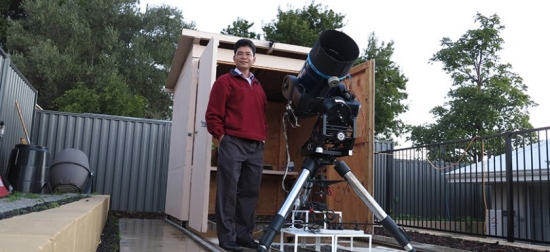
Image: Thiam-Guan Tan with his telescope. Tan notes that “A couple of sources of encouragement were The Discovery of Extrasolar Planets by Backyard Astronomers (Castellano & Laughlin, 2002) and Bruce Gary’s book Exoplanet Observing for Amateurs. Credit: Thiam-Guan Tan.
In the same vein, I’ve been looking at a project called the Habitable Exoplanet Hunting Project, emerging under the guidance of coordinator Alberto Caballero, himself a dedicated amateur astronomer in Spain who is visible on YouTube through his efforts on The Exoplanets Channel. The idea of the new project is to help amateurs discover more exoplanets in the habitable zone, restricting the search to G-, K-, and M-class stars that show low flare activity. The stars examined by the project are all known to have transiting exoplanets outside the habitable zone, and all are within 100 light years of the Sun.

How to find out whether there are as yet undetected planets around such stars? Caballero looked at the amateur astronomers involved in TRESCA (Transiting ExoplanetS and CAndidates), a group organized by the Variable Star and Exoplanet Section of the Czech Astronomical Society comprising 191 observatories. He also consulted the American Association of Variable Star Observers (AAVSO) in his quest to find amateurs willing to participate in a global venture, one that could monitor specific stars at a predetermined time each week. Needless to say, the more volunteer astronomers, the better.
Image: The Parco Astronomico Lilio Savelli, Italy, an amateur observatory participating in the Habitable Exoplanet Hunting Project. Credit: Alberto Caballero.
By gathering data 24 hours a day, seven days a week, the team hopes to monitor individual targets when a transit of a habitable zone planet could occur. 32 participating amateur observatories are already onboard as the project comes online, and Caballero notes that southern sky coverage would be particularly welcome as the effort builds. You can see photos of the participating sites, some of which are quite impressive, here.
There is no shortage of targets. Among M-dwarfs, the most numerous nearby stars, there are almost 2,000 within 100 light years, and Caballero says that amateur equipment is capable of detecting habitable zone planets like the super-Earth around LHS 1140b, with a transit depth of 0.6%, as well as smaller worlds.
Caballero likewise counts 508 G-class stars within the same 100 light year radius, and well over 900 non-flare K-class stars as well. He believes that as many as 25 habitable zone planets may be discovered using these methods, if a large enough telescope network can be implemented. The chart below, showing 10 non-flare G-, K-, and M-class stars within 100 light years with known transiting exoplanets (as of March, 2019) is drawn from the project’s website.
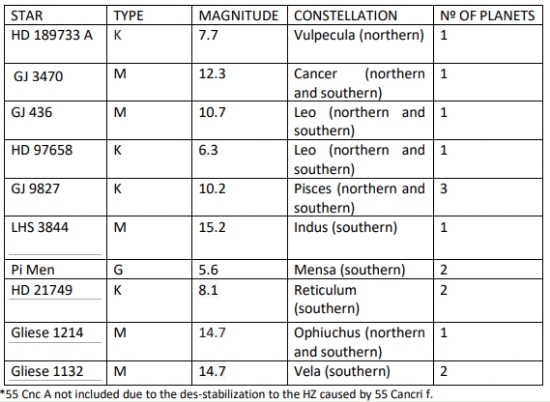
The Habitable Exoplanet Hunting Project assumes that each amateur astronomer would need to gather data from the target star about one hour per week, provided an early goal in the range of 200 observatories can be reached. From the project’s website:
To make the process easy, the observations would be conducted at the same local time of the astronomers. For those cases when there is no observatory in a specific time zone, the observations would be assigned to the closest observatory. Adjustments would also have to be made on real time to exchange observation days when skies are cloudy. In addition, considering that most of the observatories are located in the Northern hemisphere, the Southern hemisphere observatories would have to undertake more hours of observation; for that, it would be ideal the use of robotic telescopes. Getting help from Southern AAVSO observatories could also solve the problem.
M-dwarfs would seem to be prime target stars for an effort like this because habitable zone planets are going to be close enough to the host to have short orbital periods, with high transit depth, but Caballero told Jamie Carter in this article in Forbes that his team favors K-class stars, which emit lower UV and X-ray radiation than the average G star (like the Sun), and also have a longer lifetime. It’s a telling reminder that an Earth ‘twin’ may actually orbit a slightly different kind of star, where conditions for habitability could be better than here.
Caballero’s short video explains what the project hopes to accomplish, and he tells me the network will begin a campaign on GJ 3470 some time in January. Here we have a known mini-Neptune of about 14 Earth masses with a radius 4.3 times that of Earth, orbiting a star in the constellation Cancer. So far it’s the only planet known around this M-dwarf, in a tight orbit whose proximity to the host, in addition to its size, precludes habitability (in fact, its atmosphere seems to be evaporating). GJ 3470 thus offers an ideal chance for the Habitable Exoplanet Hunting Project to show what it can do even as it enjoins amateurs to bulk up its network.

A White Dwarf’s Giant Planet
Calling it a ‘chance discovery,’ the University of Warwick’s Boris Gänsicke recently presented the results of his team’s study of some 7,000 white dwarf stars, all of them cataloged by the Sloan Digital Sky Survey. One drew particular interest because chemical elements turned up in spectroscopic studies indicating something unusual. Says Gänsicke, “We knew that there had to be something exceptional going on in this system, and speculated that it may be related to some type of planetary remnant.”
And that makes the star WDJ0914+1914 an example of what a stellar system that survived, at least partially, the red giant phase of its host star might look like as a planet orbits the Earth-sized white dwarf. This work, which draws on data from the European Southern Observatory’s X-shooter spectrograph at the Very Large Telescope in Chile, confirms hydrogen, oxygen and sulphur associated with the white dwarf, all found in a disk of gas around the star rather than being present in the white dwarf itself. Subsequent work determined that the only way to produce this particular disk configuration was through evaporation of a giant planet.
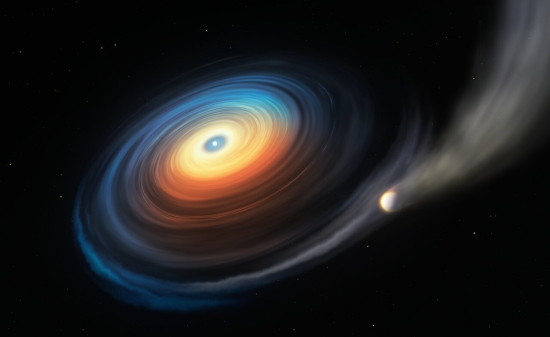
Image: Artist’s impression of the WDJ0914+1914 system. Credit: ESO.
Thus this white dwarf makes history as the site of the first detection of a surviving giant planet around this class of star. You’ll recall previous work on white dwarf atmospheres, which has given us a look at the composition of infalling material that may have been the result of the breakup of a planet, comet or asteroid (see, for example, Survivors: White Dwarf Planets).
But now we’re looking at an actual planet in the act of shedding material while still retaining its structure. The oxygen, hydrogen and sulphur found here are similar to what we see in the deeper atmospheric layers of Neptune and Uranus. Placing such a planet in a tight orbit around a white dwarf would cause high levels of ultraviolet radiation to strip away the outer atmospheric layers, creating the same kind of disk we find at WD J0914+1914.
The star’s temperature is estimated at 28,000° Celsius, while the planet is at least twice as large as the star it orbits, a world whose atmosphere is being depleted due to interactions with the star’s high energy photons. While most of the gas escapes, about 3,000 tonnes per second fall onto the disk, which is what makes the presence of the planet accessible to observers.

Image: Location of WDJ0914+1914 in the constellation of Cancer. Credit: ESO.
The planet orbits the primary at a scant 15 times the stellar radius, meaning it is 10 million kilometers away from the star, in a place that would have once been deep inside the red giant that was the white dwarf’s progenitor. The assumption here is that the planet moved closer to the star after the white dwarf had formed, perhaps through gravitational interactions with other worlds in this system. We also get a glimpse of this system’s future in the paper:
Gravitational interactions in multi-planet systems can perturb planets onto orbits with peri-centres close to the white dwarf, where tidal effects are likely to lead to circularisation of the orbit. Common envelope evolution provides an alternative scenario to bring a planet into a close orbit around the white dwarf, though it requires rather fine-tuned initial conditions and only works for planets more massive than Jupiter… As the white dwarf continues to cool, the mass loss rate will gradually decrease, and become undetectable in ~ 350 Myr… By then, the giant planet will have lost ~ 0.002 Jupiter masses (or ~ 0.04 Neptune masses), i.e. an insignificant fraction of its total mass.
The paper also notes a possible analogue to WD J0914+1914 in HAT-P-26b, a Neptune-mass planet orbiting a K-class star with a period of 4.26 days, adding that despite its high temperature, the small radius of WD J0914+1914 would make its planet cooler than the equivalent around a main sequence star. As to how common such planets may be, of the 7,000 white dwarfs examined by this study, only one planet has emerged. The authors point out that we can look forward to studying the roughly 260,000 white dwarfs identified by the Gaia mission, and thus could well find in this larger sample enough planets to make comparative study possible.
The paper is Gänsicke et al., “Accretion of a giant planet onto a white dwarf star,” Nature 576 (2019), 61-64 (abstract / preprint).


